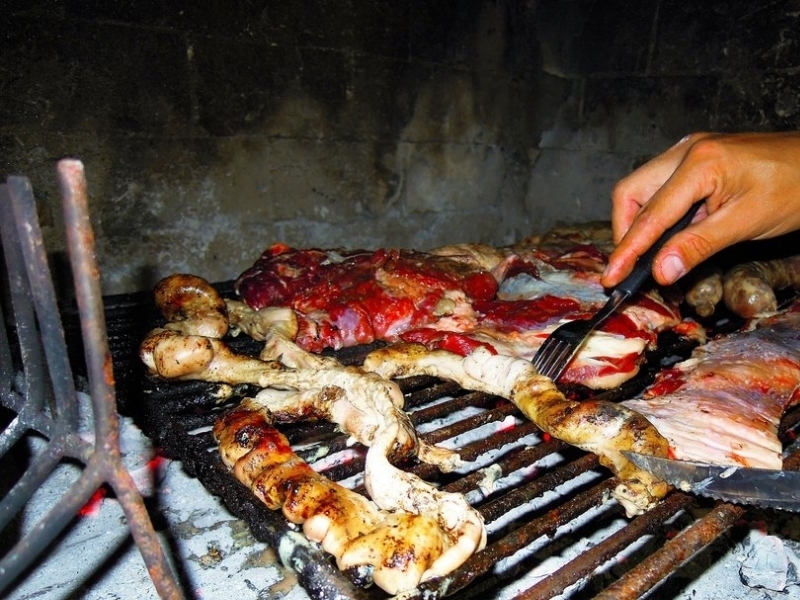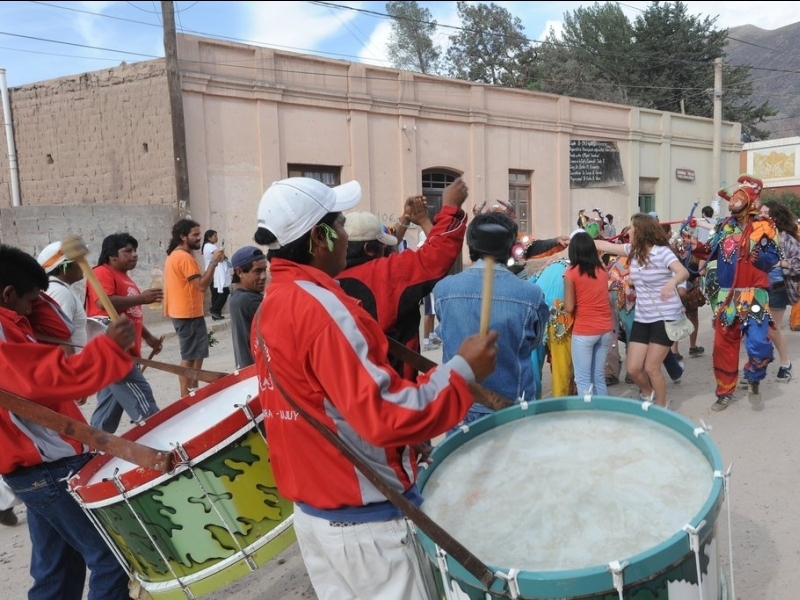News and Testimonials

Best local and cultural activities in Argentina
In Argentina, you could easily spend all your time on the major highlights. But to fully experience the Argentine lifestyle, you'll want to spend time the way locals do: sipping coffee in old-fashioned Buenos Aires cafés, riding horses on quiet ranches in the country, and cheering from the sidelines at a soccer match. Read on for more local experiences in Argentina.
Experiencing Argentina Like a Local
Tango, steak, fútbol (soccer), red wine: certain Argentinian icons are known all over the world. And with good reason — watching two dancers twirl around an open-air plaza, or two rival teams battle it out in one of South America's most famous stadiums, is a travel experience you'll never forget (they're experiences that locals often enjoy, too.) But there's more to the culture than these well-known symbols. Enjoy your steak and Malbec, then move on to discover more of the local lifestyle, from sipping mate from a gourd to riding a horse in gaucho country. Here are nine experiences that will help you have a more local experience during your travels in Argentina.
Attend an Asado (Barbecue)
Thanks to the great number of Spanish, Italian, and French immigrants who settled in Argentina in the late-18th and early-19th centuries, the Argentinian lifestyle has both European and indigenous influences. One element of the Argentinian lifestyle that's distinctly Spanish is the daily schedule: locals usually have a light breakfast, a fairly late lunch around 1-2pm, a merienda (afternoon snack) around 5-6pm, and a late dinner at 10-11pm.
There's one notable exception to the rule: the asado (barbecue), a beloved Argentinian tradition that can take up an entire afternoon or evening. Almost always on weekends, these leisurely meals include family and friends — the more the merrier, typically. If you're invited to one, say yes: it's one of the best ways to experience local culture. Bring a bottle of wine, and pace yourself, as food will be served continuously from the parrilla (grill) over several hours, and that doesn't include dessert.
Grasp the Basics of Tango
Tango is one of the most strongly identifiable aspects of Argentine culture. This style of music and dance is thought to have originated in the working-class neighborhoods of Buenos Aires and Montevideo, Uruguay in the late-19th and early-20th centuries. To this day, it's still regarded as a down-to-earth art form for people from all walks of life; both the dance and the accompanying music evoke nostalgia.
One of the best places to watch tango dancers in action is in the Buenos Aires neighborhood of San Telmo. On cobblestoned Plaza Dorrego, couples break into dance (and pass the hat to collect loose change) as locals and tourists sit at outdoor cafés, sipping coffee or beer. Milongas (tango salons) are a nightly occurrence at many venues across the city, and it's possible to just sit and watch. Taking tango lessons is an option, too, either associated with a milonga (most venues offer classes before the main event gets going) or with a private instructor at one of the city's tango "schools" or tango-themed hotels.
Participate in a Traditional Festival
Argentina has a lively cultural calendar packed with regional celebrations. Regardless of the specific event, local festivals are usually a great place to sample traditional foods, listen to folkloric music, and watch parades of dancers in colorful costumes.
In the northwest, Carnival in Tilcara (in the province of Jujuy) is a vibrant festival lasting nine days. Many festival-goers believe that the devil possesses them during this annual event, which is why they dress as devils and dance wildly. The celebrations happen at the end of January and beginning of February. Explore more of what the north has to offer with this 14-day road trip plan.
In March, meanwhile, people in Mendoza gather to celebrate the Fiesta de la Vendimia, a celebration of winemaking and vineyards. Highlights include the crowning of the reina nacional de la vendimia (national queen of wine). In San Antonio de Areco in the province of Buenos Aires, El Dia de la Tradición (Day of Tradition) takes place in November. It's a celebration of nationwide cowboy culture, with gauchos arriving from across the country to ride through the streets on horseback and display their horsemanship. The main event, the jineteada gaucha, is Argentina's version of a rodeo. Dancers and musicians further enliven the event.
Share a Gourd of Mate
Mate (pronounced ma-tay) is one of Argentina's classic refreshments. The drink is an infusion of the dried leaves of the yerba mate plant, soaked in hot water inside a hollowed-out gourd with a metal straw. When someone offers you the chance to share a gourd, they're inviting you to participate in one of the country's most important social customs. Invented by the Guaraní, an indigenous group native to parts of Argentina, Uruguay, Brazil and Paraguay, mate later became synonymous with gaucho culture. Today, it's a drink that's widely popular.
There's no one set time or place to consume it — many Argentines have mate for breakfast, or while working at the office, or while relaxing on the beach (or all of the above). Sharing mate is a form of social bonding: everyone in the group drinks out of the same gourd and sips from the same straw.
Cheer on a Local Team at a Football Match
Argentines' legendary passion is on full display during fútbol (soccer) matches: here, the sport is almost like a religion. One of the biggest athletic rivalries anywhere in the world is that between Buenos Aires' two top teams, Boca Juniors and River Plate. A match between them (called the Superclásico) offers incredible atmosphere, whether you're at the stadium or watching at a local bar. If you can swing it, try to get tickets to a match at Boca Juniors' stadium in the La Boca neighborhood of Buenos Aires: it's known as La Bombonera because of how the stadium's shape resembles a box of chocolates.
Indulge in Merienda (Afternoon Tea)
There's a long gap between when Argentines eat lunch (1-2pm) and when they settle down for dinner (around 10 or 11 pm). How do they keep going? Largely through merienda, or late afternoon tea. Observed in family homes and cafés alike, usually around 5-6pm, the merienda is a feast of facturas (pastries), tostadas (toast served with butter, cheese, or the caramel-like spread called dulce de leche) and other sweet treats like alfajores (the local version of a sandwich cookie). The accompanying drinks are mate, coffee or tea. Whether in a home or in a public space, the merienda is a great opportunity to gain an insight into how locals socialize: the occasion is usually exuberant and family-oriented.
Taste Malbec at a Winery
Argentinians are justifiably proud of their locally produced wines, particularly deep, dark, richly fruity Malbec, whose grapes were introduced from France in the 19th century. The bodegas (wineries) in the Mendoza region are often open to the public, though reservations and a small entrance fee are usually required. They're a great excuse to get out into some of Argentina's most beautiful scenery: you can see snow-capped Andes mountains from most of the vineyards.
There are many opportunities to have a local experience in wine country, too. When visiting wineries, you'll get the chance to interact with people who work in the industry, and there are plenty of festivals where you can sip and swirl alongside Mendoza residents.
Take a Trip to an Estancia (Ranch)
Do as the locals do and get out of the city for a quiet break at an estancia, or ranch. For centuries, the economy of Argentina's grassy interior has been driven by these large-scale working farms that cover hundreds (if not thousands) of acres, rearing the cattle for Argentina's booming beef trade. The typically photogenic, white-walled, terracotta-roofed farm buildings are often associated with some fantastic historic figures and stories: Argentina's most famous son, Che Guevara, lived on an estancia near Córdoba for a time.
But perhaps the main appeal of staying on an estancia is the glimpse you'll get into rural life. Apart from enjoying traditional asados and meriendas, you'll see gauchos tending to the cattle on horseback and have a chance to go horseback riding.
People-Watch in a Café
Argentina is full of grand old cafés, many well over a century old. Nowhere is café culture more advanced or sophisticated than in Buenos Aires, where a staple of the day for any local is taking time out for a coffee. The café is considered a refuge from the hectic pace of the city, an important place for social interaction and a link to Buenos Aires history, with many of its most famous residents associated with one café or another at some point. Even if you'ree alone, cafés provide some great people-watching. Café Tortoni is the city's most famous café, in operation since 1858.










